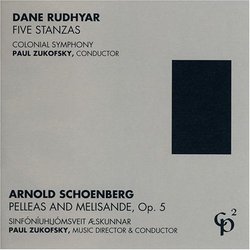| All Artists: Dane Rudhyar, Arnold Schoenberg, Paul Zukofsky Title: Dane Rudhyar: Five Stanzas; Arnold Schoenberg: Pelleas and Melisande, Op. 5 Members Wishing: 2 Total Copies: 0 Label: Cp2 Records Release Date: 12/12/1995 Genre: Classical Styles: Chamber Music, Forms & Genres, Theatrical, Incidental & Program Music, Historical Periods, Classical (c.1770-1830), Modern, 20th, & 21st Century, Symphonies Number of Discs: 1 SwapaCD Credits: 1 UPC: 096661010526 |
Search - Dane Rudhyar, Arnold Schoenberg, Paul Zukofsky :: Dane Rudhyar: Five Stanzas; Arnold Schoenberg: Pelleas and Melisande, Op. 5
 | Dane Rudhyar, Arnold Schoenberg, Paul Zukofsky Dane Rudhyar: Five Stanzas; Arnold Schoenberg: Pelleas and Melisande, Op. 5 Genre: Classical
Five Stanzas for String Ensemble, dedicated to Carl Ruggles, pioneer and friend, was composed in Hollywood, California, from December 6 to December 26, 1927, and the final score was written during the following weeks. I ha... more » |
Larger Image |
CD Details
Synopsis
Album Description
Five Stanzas for String Ensemble, dedicated to Carl Ruggles, pioneer and friend, was composed in Hollywood, California, from December 6 to December 26, 1927, and the final score was written during the following weeks. I had met Carl Ruggles in December 1922, when I went to New York to play some of my earlier piano compositions at a concert of the International Composers Guild, of which I had been a founding member a year before. The score of Five Stanzas was printed in the quarterly New Music Orchestra Series that Henry Cowell had started in 1926 with some assistance from Charles Ives, whom I was to meet shortly thereafter. The work was first performed by Friedrich Cerha, director of the Austrian Radio Orchestra, in March 1975. Paul Zukofsky's performance at the Kennedy Center for the Performing Arts on March 10, 1982 was for me a most memorable event, because of the excellence and intensity of the interpretation and the extraordinary warmth of the audience's reception. The work has a lyrical quality sustained through the five sections. It is truly a "poem" in five stanzas, but I had no story or personal drama in mind when I composed it. Much of the melodic thematic material is given to the lower string instruments, which at times fulfill an almost declamatory function, apparent in the very first bars of the first Stanza marked "tragic and passionate." The second Stanza, "scherzando," starts in a playful mood, but soon the celli, violas, and basses unfold an intense melodic pattern of large intervals, taken up a little later by the violins and whole orchestra. The section ends with a repeat of the beginning. The third Stanza is an "andante expressivo" featuring softly dissonant harmonic progressions of sevenths and a contemplative mood. The fourth Stanza, "allegro rubato energico," is a fast and tumultuous movement. The work ends with the longest section, "moderato," in which the lower strings develop their declamatory message ending in vast chords spread out in fifths throughout the whole available spectrum of sound. The Five Stanzas belong to a period which began in 1924 when, after two years away from composing, I developed the concept of "dissonant harmony" and resonance in a series of piano compositions--first in the four Pentagrams (1924-26), then in Paens (1926), and the second through the eighth Tetragrams (1924-29). I have referred to this music as "music of speech" to distinguish it from the music of the classical tradition (suites, sonatas, symphonies) so often based on dance rhythms or physical motions framed by rigid systems of formal development. My music is essentially subjective, evoking psychological feeling-experiences. It is meant to speak directly to the inner nature. It is never "made" as an object according to traditional or fashion-directed patterns.

 Track Listings (15) - Disc #1
Track Listings (15) - Disc #1